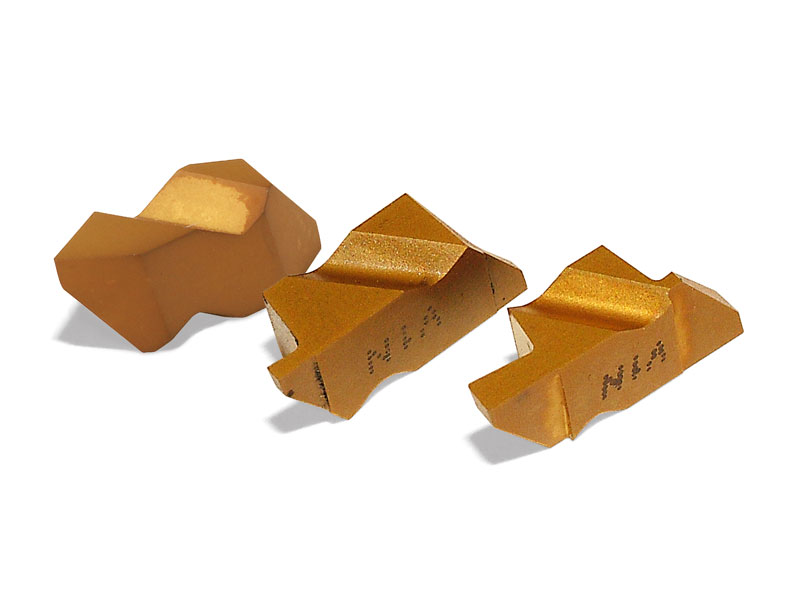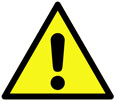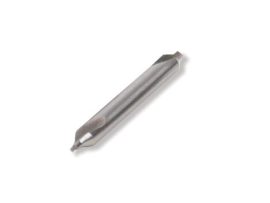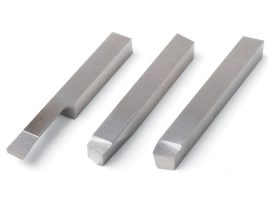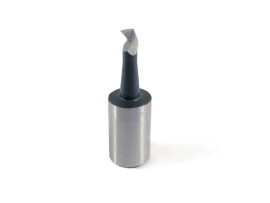Carbide Inserts (thread, groove)
These Carbide inserts are used in the Insert Tool Holder and are used for either threading or grooving.
Thread Cutting
- 60° threading insert for cutting outside threads (P/N 22675)
Groove Cutting Inserts (available in multiple widths and profiles)
Standard Grooves
- .031″ insert (P/N 2269)
- .062″ insert (P/N 2270)
- .094″ insert (P/N 22694)
- .125″ insert (P/N 22695)
Radial Grooves
- .031″ radius insert (P/N 22692)
- .062″ radius insert (P/N 22693)
-
| P/N 22675 – 60° THREADING INSERT | |
| INSERT SIZE | 2 |
| CORNER RADIUS CENTER (RC) | .0040(in), 0.1000 (mm) |
| PROFILE DISTANCE (E) | .075 (in), 1.90 (mm) |
| EXTERNAL THREAD PITCH | 1.25-3.5 (in), 0.70-3.0 (mm) |
| EXTERNAL TPI | 8-36 |
| INTERNAL TPI | 7-20 |
| GRADE | SKC5025 |
| P/N 2269 – .031 GROOVING INSERT | |
| INSERT SIZE | 2 |
| CUTTING WIDTH (W) | .031 (in), 0.79 (mm) |
| CUTTING WIDTH TOL ± | .001 (in), 0.03 (mm) |
| CORNER RADIUS (RR) | .0035 (in), 0.09 (mm) |
| CUTTING DEPTH (T) | .050 (in), 1.27 (mm) |
| GRADE | SKC5025 |
| P/N 22692 – .031 RADIUS GROOVING INSERT | |
| INSERT SIZE | 2 |
| CUTTING WIDTH (W) | .062 (in), 1.575 (mm) |
| CUTTING WIDTH TOL ± | .001 (in), 0.03 (mm) |
| CORNER RADIUS CENTER (RR) | .031 (in), 0.775 (mm) |
| CUTTING DEPTH (T) | .011 (in), 2.794 (mm) |
| GRADE | SKC5025 |
| P/N 2270 – .062 GROOVING INSERT | |
| INSERT SIZE | 2 |
| CUTTING WIDTH (W) | .062 (in), 1.58 (mm) |
| CUTTING WIDTH TOL ± | .001 (in), 0.03 (mm) |
| CORNER RADIUS (RR) | .0075 (in), 0.19 (mm) |
| CUTTING DEPTH (T) | .110 (in), 2.79 (mm) |
| GRADE | SKC5025 |
| P/N 22693 – .062 RADIUS GROOVING INSERT | |
| INSERT SIZE | 2 |
| CUTTING WIDTH (W) | .125 (in), 3.175 (mm) |
| CUTTING WIDTH TOL ± | .001 (in), 0.03 (mm) |
| CORNER RADIUS (RR) | .062 (in), 1.6 (mm) |
| CUTTING DEPTH (T) | .11 (in), 2.794 (mm) |
| GRADE | SKC5025 |
| P/N 22694 – .094 GROOVING INSERT | |
| INSERT SIZE | 2 |
| CUTTING WIDTH (W) | .094 (in), 2.39 (mm) |
| CUTTING WIDTH TOL ± | .001 (in), 0.03 (mm) |
| CORNER RADIUS (RR) | .01 (in), 0.005 (mm) |
| CUTTING DEPTH (T) | .10 (in), .15 (mm) |
| GRADE | SKC5025 |
| P/N 22695 – .125 GROOVING INSERT | |
| INSERT SIZE | 2 |
| CUTTING WIDTH (W) | .125 (in), 3.18 (mm) |
| CUTTING WIDTH TOL ± | .001 (in), 0.03 (mm) |
| CORNER RADIUS (RR) | .0075 (in), 0.19 (mm) |
| CUTTING DEPTH (T) | .110 (in), 2.79 (mm) |
| GRADE | SKC5025 |
Related products
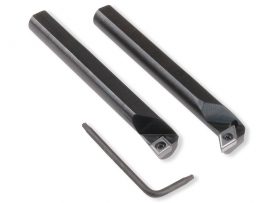

LH 55° & 80° 3/8″ Boring Bars w/Carbide Inserts
These 3/8" diameter boring bars hold a carbide insert secured with a Torx screw. Each comes with either a 2-sided 55° or 80° carbide insert and Torx wrench. The 55° LH boring tool will fit into a 3/4" starting hole. The 80° holder will fit into a smaller 1/2" hole. The 80° holder offers a little more strength for roughing cuts while the 55° insert will cut into sharper corners. The 3-1/4" long holder can bore a hole a little over 2" deep with two fastening screws tightened on it. The holders are made from 1144 Stress-proof steel with a black oxide finish. Available individually.
Left Hand Boring Bars
These LH boring bars are not intended to be used for boring on a standard Sherline lathe, as the spindle is not reversible without electronic modifications. They were developed for a Sherline tool that is now in development where they will be used as a turning tool from the backside with the bit upside down. Watch for the introduction of this new “chucker” lathe soon.
Advantages of Using Carbide Insert Tools
Though relatively expensive, if a cutting edge of a carbide insert becomes dull or chipped, the insert can be removed and rotated 180° to expose two new cutting surfaces, providing, in effect, two tools for the price of one.
The primary method of cutting metal on miniature machine tools is usually with high-speed steel tools as they are inexpensive, easily resharpened and can be ground into "form" tools for special jobs. However, inserted tip carbide tools can be lifesavers for some jobs. Though more expensive and not able to be resharpened, carbide tools hold their cutting edge when cutting exotic metals like stainless steel or titanium or abrasive materials like carbon fiber and can speed up the cutting process. This is why they are used for most cutting tasks in the modern professional machine shop.
NOTE: A tool is named by the direction from which the chip leaves the tool; so a right-hand tool has its cutting edge on the left and the chip peels off to the right.